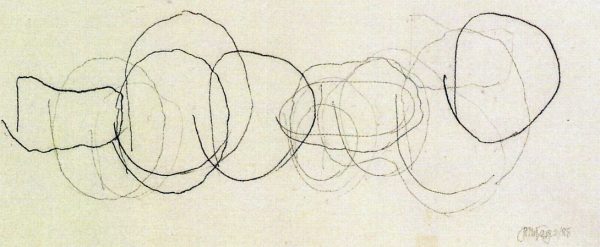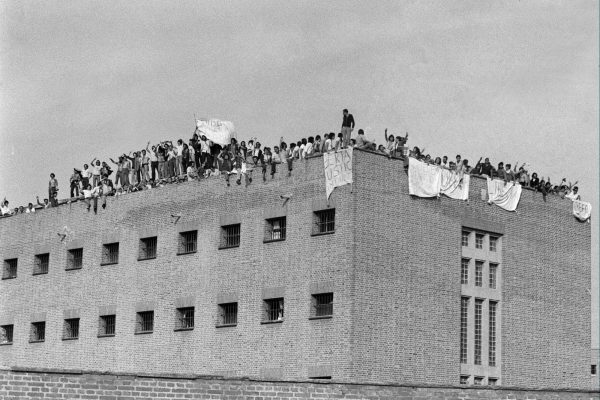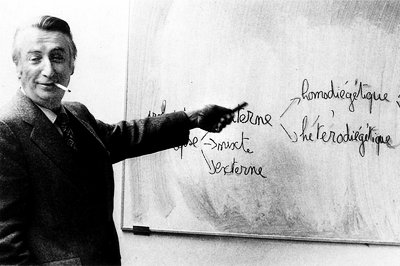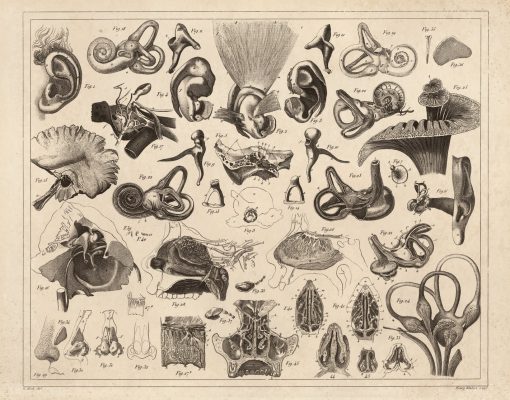The way I see it, the avant-garde emerged at a point when the professionalisation of artists had consumed itself and it became necessary to start again from scratch. Art had already been invented, and the only thing to be done was to go on producing works, and the myth of the avant-garde came about to restore the possibility of making the journey from the origin again.
If the actual process had taken two or three thousand years, what the avant-garde proposed could only function as a simulacrum or a pantomime version, hence the ludic, or at any rate the not-too-serious quality, the carnivalesque instability which avant-garde movements have possessed. But history abhors stable situations, and the avant-garde was the response of a social practice – art – the purpose of which was to recreate an evolutionary dynamic.
In effect, once the ‘professional’ novel – if we limit ourselves to the art of the novel – had come into existence, in a state of perfection that cannot exceed its premises (the novel of Balzac, Dickens, Tolstoy, Manzoni), it runs the risk of becoming congealed. One could say that if the only risk is that novelists might keep on writing like Balzac, then it is a risk we are willing to take, and with pleasure. But in reality it’s optimistic to talk of a mere ‘risk’ because this process of congealment has actually taken place. Thousands of novelists have continued to write Balzacian novels during the twentieth century: an unending stream of commercial fiction, fleeting, frivolous novels written for the purposes of either entertainment or ideology. To take even a single step further, as Proust did, requires a colossal effort and the sacrifice of an entire life. The law of diminishing returns comes into play: the innovator covers almost all the ground in his initial attempt, leaving his successors a space that gets smaller every day and in which it’s more and more difficult to move forward.
Once a professional novelist is established, he has two equally melancholy alternatives: to keep writing the ‘old’ novels in updated settings; or to heroically attempt to take one or two more steps forward. This last possibility turned out to be a dead end within a few years: while Balzac wrote fifty novels, and still had time to live, Flaubert wrote five, shedding blood in the process. Joyce wrote two, and Proust a single novel, and it was a work that took over his life, absorbing it, a kind of inhuman hyperprofessionalism. The fact is that being able to make a living from literature was a momentary and precarious state which could only happen at a determined moment in history. I would even say that it was only, and could only ever have been, a promise, in the process of being formed; by the time it had come into being, it was already time to look for something else.
Luckily, there is a third alternative: the avant-garde, which, as I see it, is an attempt to recuperate the amateur gesture, and to place it on a higher level of historical synthesis. In other words, it implies immersing oneself in a field which is already autonomous and considered valid by society, and inventing new practices within that field to restore to art the ease with which it was once produced.
Professionalisation implies specialisation. Because of this, avant-garde movements return over and over again, with distinct variations, to Lautréamont’s famous declaration: ‘Poetry must be made by all, not by one.’ It seems wrong to interpret this quotation in a purely quantitative, democratic sense, or as one expressing good utopian intentions. Perhaps it’s the other way around: when poetry is something that everyone can do, the poet will be able to be a man like any other, and will be liberated from all that psychological misery we call talent, style, mission, work, and other forms of torture. Then it won’t be necessary to be wretched, or to suffer, or to be enslaved to a labour which society appreciates less and less.
The historicity of art was endangered by professionalisation; at any rate it imprisoned the historical within content, leaving form congealed. To put it another way, it shattered the form-content dialectic which makes art ‘artistic’.
More than this, professionalisation restricted the practice of art to a tiny specialist social class, causing it to lose the richness of the experiences of the rest of society. Artists felt they had an obligation to ‘give voice to the voiceless’, just as the writers of fables had done, making donkeys speak, as well as parrots, farmers, flies, chairs, kings and clouds. Personification invaded the art of the twentieth century.
In my personal vision, procedure is the avant-garde’s principal tool. From a negative point of view, procedure is a shallow simulacrum of the process by which a culture establishes the modus operandi of the artist. For the avant-gardes, it is the only remaining way of reconstructing the radicalism which is an essential part of art. But really, critical opinion doesn’t matter. The avant-garde, by its very nature, incorporates ridicule, making it just another feature of its work.
When understood in this sense – as inventors of procedures – the relevance of avant-garde artists today is clear: they have populated the twentieth century with treasure maps waiting to be discovered and exploited. Constructivism, automatic writing, the ready-made, dodecaphonism, cut-ups, chance, indeterminacy: the great artists of the twentieth century are not those who created works, but those who created procedures through which works could be made alone, or indeed, not made. For what purpose do we need works of art? Who needs another novel, another painting, another symphony? As if there weren’t enough already!
A work of art will always have value as an example, and one example is just as good as another, hardly varying in their powers of persuasion. But, in any case, we’re already convinced.
The question is to decide if a work of art is a particular case of a general feature of the art form or the genre in question. If one says ‘I’ve read many novels; Don Quixote for example,’ we suspect that justice is not being done to that work; we are extracting it from History in order to put it on the shelf of a museum or supermarket. Don Quixote is not one novel among many, but the phenomenon, unique and unrepeatable – historical, one might say – from which the definition of the word ‘novel’ is derived. In art, examples are not examples because they are unique, specific inventions, ungoverned by any generalisations.
When a civilisation gets old, there are two alternatives: keep making works of art, or to reinvent art itself. But it is this very process of ageing which gives to a civilisation its stock of inventions, which are already used up. As a result, this second choice becomes more and more difficult and costly and less gratifying. That is, unless we do what the avant-gardes did and take a shortcut by resorting to procedure, something which will always seem a little irresponsible or barbarous.
If art had become the mere production of works, overseen by those who already knew how to, and were able to, produce them, the avant-garde intervened in order to reactivate the process from its roots, and did it by putting processes back on the throne which had been occupied until then by results. This achievement also has other implications: that art can be made by all, that it can be liberated from psychological restrictions, and most of all, that what we think of as the ‘work’ can be the method by which the work is made, rather than the actual work itself, the work acting as a kind of documentary appendix which serves only as a means of deducing the process from which it arose.
I want to illustrate this last point using one of my favourite artists, an American composer, John Cage, whose body of work is an inexhaustible mine of procedures. The fact that Cage was a musician does not mean that I am no longer speaking about literature; on the contrary, to say that ‘poetry should be made by all, not by one’ also signifies that this ‘one’, when put into action, will make art of every type. Procedure establishes a communication between art forms. It is the footprint left by an Edenic system of arts, in which they all once formed a single art form, and the artist was a non-specialist, and an amateur. For this reason I bring up John Cage at this point not to provide an example, for he is not just an example but the very thing I’m talking about.
His story is well known: a young man who wanted to be an artist, who had not fulfilled any of the conditions for becoming a composer and nevertheless ended up becoming one… the essence of the avant-garde is strained through a defect in causality. In the old days the lives of musicians were lived in reverse with Mozart’s life as the canon; predisposition was so important, and cause such a huge determining factor that it was always necessary for the story to take a step back into biography, to early infancy, to the cradle and further still, right up to the parents and grandparents, before it could be given a beginning. With Cage cause floats, uncertain, and in practice is to be found journeying towards old age. During the last years of his life he managed to determine a cause that did his work justice, in the beautiful pieces with numbers as titles that he composed between 1987 and his death in 1992. The advantage of this prolonged deferral of cause was that it became necessary to invent a cause every time: he never had a definite, prior motive for being a musician; had he had one, he would not have been able to do anything more than creating works. As it was he had to do something different. A succinct examination of one of his inventions – Music of Changes, composed in 1951 – will clarify this difference.
Music of Changes is a piece for solo piano, which was created using the hexagrams of the I Ching or Book of Changes as a method. It was created using chance; one could not say that it was ‘composed’, because this verb signifies a deliberate putting into use of its distinct elements. Here composition has been the object of a methodical annulation.
Cage used three eight by eight tables, adding up to sixty-four squares in each table, which is the exact amount of hexagrams contained in the I Ching. The first table contained the sounds; each square possessed a ‘sound event’, that is, one or several notes. Only the odd squares had any sounds in them; the even ones were empty, which indicated silence. The second table, which also had sixty-four boxes, determined the durations, which don’t happen in any particular metre. Here all sixty-four boxes are filled, because duration governs silence and sound equally. The third grid, in which only one in every four of the squares are used, is for the dynamics, from pianissimo all the way to fortissimo, to be put to use alone or in a combination, in other words, from one notation to another.
Tossing two coins six times decided a hexagram from the I Ching. The number of that hexagram referred to a box in the sound grid. Tossing the coins another six times determined the duration which would be applied to the sound chosen previously, and the third series of tosses determined the dynamics. (There was also another, fourth, grid which decided the density: the amount of layers of sound – between one and eight – which each moment could have was also determined by chance). The extension and the structure of its four parts, as well as the total duration, were also determined by chance.
The methodical and purely automatic task of determining one note after the other makes the piece from beginning to end. What does it sound like? The premises of its construction mean that there is little possibility of its sounding like anything whatsoever. There can be no melodies or rhythms or progression or tonality or anything. Unless they come about by chance, or to put it another way, if chance is willing, there will be all of these things.
It’s curious, but although one could well say that, given the procedure behind it, the piece should sound completely impersonal and impossible to locate in space or time, it sounds intensely like 1951, like the work of a North American disciple of Schoenberg, and it is very characteristic of Cage himself. How can this be? All that Cage did in 1951 was decide upon the method; as soon as the writing began, the date, the personality and the civilisation they were a part of ceased to exist. If the date, personality and civilisation continue to be present in the finished product it shows that we have been mistaken in assigning their presence to psychological processes present in the act of composition.
Let us suppose that Chopin’s Nocturnes had been written using the same method. Not necessarily using the I Ching, but with the tables for each element, using chance to choose between them. It is not such an outrageous idea, because these tables have always existed, if only in a virtual state; and the actualisation of their elements has always been carried out more or less by chance, with the difference that this chance has been called inspiration, or impulse, or even necessity. In order to maintain tonality, or metre, it was necessary only to prepare tables ad hoc. Of course, romanticism would not have been able to renounce the privileges of the ‘I’ without corrupting its own myth. The constructivism against which it was a reaction tended towards impersonality, and it cannot be surprising that this movement experimented with chance. In the period immediately succeeding Bach, composition was occasionally done by chance, using dice; Mozart, Haydn and Carl Philipp Emanuel Bach all did it, among others. The entrance of the artist’s personality, his sensibilities and the political complications of the ‘I’ began with romanticism, and took a whole century to run their course. The great mechanic Schoenberg upped the pressure on the professionalisation of the musician, and made way for the arrival of a new type of artist: the musician who is not a musician, the painter who is not a painter, the writer who is not a writer. Already, in 1913, Marcel Duchamp had done an experiment in the same sense, of determining notes by chance, but without executing it; he thought that realising it would be ‘very useless’. In effect, what is the point in making work, once you know how to make it? The work would only serve to feed consumption, or to satisfy a narcissistic impulse.
Cage justified the use of chance, saying that ‘in such a way it’s possible to make a musical composition … the continuity of which is free of individual taste and memory (psychology) and also of the literature and “traditions” of the art’. What he calls ‘literature’ and ‘the traditions of the art’ is nothing less than the canonical way of making art, which comes into being by means of ‘individual memory and taste’. The avant-garde artist creates his own method, his own canon, an individual way of restarting the labour of art from zero. He does so because in his – our – age, traditional methods were found to be already useless, spent, and the artist’s task became removed from the creation of art and became the production of works of art, losing something that used to be essential. There is nothing new about this – Saint Augustine said that only God knew the world, because he made it. We don’t, because we didn’t make it. Art would then be the attempt to achieve knowledge by constructing the thing that is to be known, the object in question being none other than the world. The world understood as a means of communication. It is not, then, a case of knowing but of acting. And I think that the healthiest aspect of the avant-garde, of which Cage is the epitome, is its placing action back on centre stage, regardless of whether it appears frenetic, ludic, directionless or indifferent to the results. In order to keep on being action it has to be indifferent to results.
Cage’s procedure of using tables of elements could work for any other art form. In painting there would be tables of basic forms, colours and sizes, and any method based on chance for the purpose of choosing which ones to actualise in the painting. Architecture could also be practised in this way, as could any kind of art – theatre, ceramics, and of course, literature.
In sharing procedures, all art forms communicate amongst themselves; they communicate through their origin or through the way they are generated and, in going back to its roots, the game starts over again.
In general, procedures of any kind consist in going back to the roots. As such it is the case that, nowadays, art that does not use a procedure is not truly art. This radicality is precisely what distinguishes authentic art from mere language use.
share
ABOUT THE CONTRIBUTOR
César Aira
was born in Coronel Pringles, Argentina, in 1949. His many books include How I Became a Nun (1993), The Literary Conference (2006), The Miracle Cures of Dr. Aira (2012), The Conversations (2014) and The Musical Brain, forthcoming from New Directions in 2015.
RAHUL BERY lives in Cardiff and translates from Spanish and Portuguese into English. His most recent translations are Nothing Can Hurt You Now by Simone Campos and Mary John by Ana Pessoa (co-translated with Daniel Hahn). He is currently working on a translation of Centroeuropa by Vicente Luis Mora.




